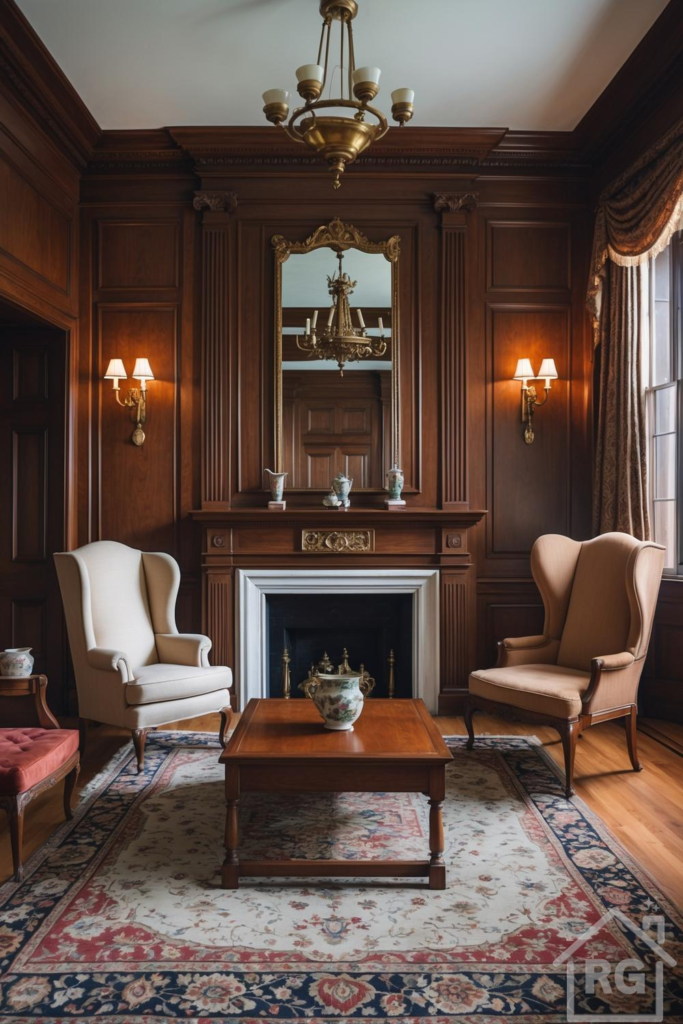
The Enduring Allure of Colonial Revival: Crafting Timeless Elegance
Step into a world where history whispers from every corner, craftsmanship is revered, and an air of quiet dignity pervades. This is the essence of the Colonial Revival interior, a style that harks back to early American design yet continues to captivate with its timeless appeal.
Born in the late 19th and early 20th centuries, this architectural and decorative movement sought to celebrate and reinterpret the simplicity and sturdy elegance of colonial-era homes. It’s a style characterized by symmetry, classical details, and a profound respect for history, resulting in spaces that feel both formal and inviting, grand yet deeply comforting.
If you’re drawn to interiors that exude warmth, character, and a sense of enduring style, the Colonial Revival living room might be your perfect sanctuary. This guide will walk you through the key elements and offer practical tips to help you achieve this distinguished look in your own home.
Deconstructing the Look: Key Elements of a Colonial Revival Living Room
Creating an authentic Colonial Revival living room involves a careful interplay of architectural features, color palettes, materials, furnishings, and lighting. Each element contributes to the overall narrative of historical reverence and sophisticated comfort.
The Foundation: Architectural Integrity and Grandeur
The soul of a Colonial Revival room often lies in its architectural bones. These elements provide the distinguished backdrop against which all other design choices unfold.
- Rich Wood Paneling: Often the star of the show, extensive wood paneling is a hallmark. Think deep, lustrous tones of mahogany, walnut, or cherry, meticulously crafted and polished to a soft gleam. This paneling, whether full-height or wainscoting, envelops the room in warmth and imparts a sense of gravitas. The wood itself tells a story, its grain and color adding depth and texture.
- The Fireplace as Focal Point: A prominent fireplace is non-negotiable. It serves as the heart of the room, a symbol of warmth and gathering. Mantels are typically substantial, often crafted from wood to match the paneling or from classic stone like marble. Intricate carvings, dentil molding, or pilasters might adorn the mantelpiece, further enhancing its importance.
- Symmetry and Proportion: Colonial Revival design heavily emphasizes balance and order. This is evident in the symmetrical arrangement of windows, doors, and even furniture. A pair of sconces flanking the fireplace, or two identical armchairs facing each other, reinforces this sense of harmony and classical proportion.
- Mouldings and Trim: Elaborate mouldings are crucial. Crown molding defines the transition between wall and ceiling, often with detailed profiles. Chair rails, picture rails, and substantial baseboards add layers of architectural interest and contribute to the room’s formal character.
A Palette of History and Warmth: Colors that Speak Volumes
The color scheme in a Colonial Revival living room is typically rich, warm, and drawn from historical precedents.
- Deep Wood Tones: As mentioned, the natural color of the wood paneling and furniture—ranging from medium browns to deep, reddish browns—forms the dominant part of the palette.
- Creamy Neutrals: To balance the richness of the wood, walls (if not fully paneled) and ceilings are often painted in soft, creamy off-whites, beiges, or pale yellows. These lighter tones reflect light and prevent the room from feeling overly dark.
- Historic Accent Colors: Accents are introduced through textiles and accessories. Think of muted, sophisticated shades like deep burgundy or crimson red, stately navy or Williamsburg blue, forest or sage green, and even touches of mustard yellow or burnished gold. These colors add depth and personality without overwhelming the space.
Textures and Materials: A Tactile Journey Through Time
The interplay of textures is vital in creating an inviting and authentic Colonial Revival space. The materials chosen speak of quality and tradition.
- The Dominance of Wood: Beyond paneling, wood is present in flooring (often polished hardwood, perhaps with inlaid borders) and, of course, furniture. The smooth, cool touch of polished wood is a defining sensation.
- Classic Upholstery Fabrics: Seating is typically upholstered in durable, high-quality fabrics. Consider linens, wools, damasks with subtle patterns, or even velvet for a touch of luxury. The feel of these fabrics should be substantial and comfortable.
- Woven Rugs: Large, traditional area rugs are essential. Oriental, Persian, or Savonnerie-style rugs with intricate patterns and rich colors anchor seating areas, add warmth underfoot, and introduce another layer of texture and historical reference.
- Gleaming Metallic Accents: Polished brass is the metal of choice for lighting fixtures, hardware (like drawer pulls and doorknobs), and decorative objects. Its warm, golden gleam adds a touch of brightness and sophistication.
- Natural Stone: Marble, slate, or soapstone are often used for fireplace surrounds or hearths, providing a cool, smooth contrast to the warmth of the wood.
- Crisp Glass and Fine Ceramics: Glass in mirror surfaces and the delicate shades of light fixtures adds sparkle, while fine ceramic vases and decorative pieces introduce elements of refined craftsmanship.
Furnishing with Grace: Iconic Pieces and Timeless Silhouettes
Furniture in a Colonial Revival living room is characterized by classic lines, sturdy construction, and a sense of formality, though comfort is also key.
- Distinguished Seating: Wingback armchairs are iconic, offering both comfort and a stately presence. Camelback sofas, with their gracefully curved backs, are another popular choice. Look for pieces inspired by 18th-century styles like Queen Anne or Chippendale, often featuring details like cabriole legs or carved motifs.
- Elegant Tables: Coffee tables, side tables, and console tables are typically made of dark, polished wood such as mahogany, walnut, or cherry. Styles like pedestal tables, drum tables, or those with turned legs are common.
- Substantial Storage and Display: Built-in or freestanding bookcases are a natural fit, often filled with leather-bound volumes. Breakfronts or secretaries can display fine china or collectibles, adding to the room’s cultured atmosphere.
Illuminating the Past: Layered Lighting Choices
Lighting in a Colonial Revival room aims to create a warm, inviting ambiance while highlighting the room’s features.
- Statement Chandeliers: A brass chandelier, often with multiple arms and candelabra-style lights (perhaps with small shades), frequently serves as a central lighting element, adding a touch of grandeur.
- Elegant Wall Sconces: Sconces, typically in brass and often in pairs, flank fireplaces, mirrors, or important architectural features. They provide soft, ambient light and contribute to the room’s symmetry.
- Classic Table and Floor Lamps: Lamps with traditional fabric shades (often silk or linen, sometimes pleated) on bases of brass, ceramic, or dark wood provide task and accent lighting.
- Layering Light: The goal is to create multiple layers of light—ambient, task, and accent—that can be adjusted to suit the mood and occasion.
Decorative Accents: The Finishing Touches of Authenticity
Accessories are chosen to enhance the historical theme and add personality.
- Ornate Mirrors: Large, gilt-framed mirrors, often with intricate carvings or Federal-style motifs (like eagles), are frequently placed above mantels to reflect light and add a sense of space and grandeur.
- Appropriate Artwork: Consider period-appropriate artwork such as portraits, landscapes, maritime scenes, or botanical prints, often in substantial frames.
- Rich Textiles: Beyond upholstery, textiles include formal window treatments like heavy drapes in damask, silk, or toile, often with valances or swags. Throw pillows in complementary fabrics add comfort and color.
- Curated Collectibles: Antique-style accessories like ceramic ginger jars or vases, grandfather clocks, silver tea sets, or brass candlesticks complete the look. The key is curated elegance, not clutter.
Bringing Colonial Revival Elegance to Your Home: Practical Tips for Implementation
Achieving this sophisticated style is a rewarding endeavor. Here’s how to approach it:
Start with the Architectural Bones
If your home lacks original features, consider adding them. Wainscoting, substantial crown molding, and a well-designed fireplace surround can make a significant impact. Even picture frame molding on plain walls can evoke a paneled feel. Focus on creating a strong architectural framework.
Choose Your Color Scheme Thoughtfully
Select a dominant wood tone as your anchor. Balance this with creamy neutrals for walls and ceilings to maintain brightness. Introduce your chosen historic accent colors—perhaps a deep red, a muted blue, or a forest green—through rugs, upholstery, drapes, and accessories. Test paint colors in different lights before committing.
Sourcing Furniture: Quality and Silhouette
Look for high-quality antique pieces or well-made reproductions. Focus on classic silhouettes like wingback chairs, camelback sofas, and Chippendale-style tables. Don’t be afraid to mix pieces, but ensure they share a common design language in terms of period influence and formality. Estate sales, antique shops, and reputable reproduction furniture makers are good sources.
Layering for Coziness and Visual Depth
The richness of Colonial Revival design comes from layering. Combine the smooth texture of polished wood with the softness of upholstered pieces, the plushness of a wool rug, and the crispness of linen or silk drapery. This textural variety is key to creating a room that feels both luxurious and inviting.
The Art of Arrangement: Symmetry and Conversation
Embrace symmetry in your furniture layout. A typical arrangement might involve a sofa facing the fireplace, flanked by a pair of armchairs. Create distinct conversational groupings. Ensure there are clear pathways and that the scale of the furniture is appropriate for the room size.
Personalizing Your Colonial Revival Space
While adhering to the style’s principles, infuse your personality. Incorporate family heirlooms, meaningful artwork, or collections that speak to you. Books are always a welcome addition, lending an air of intellect and warmth. The aim is a lived-in elegance, not a museum replica. Keep accessories curated and avoid clutter to let the quality of the design and furnishings shine.
The Immersive Sensory Experience of a Colonial Revival Room
A well-executed Colonial Revival living room engages more than just the eyes. Imagine the visual feast: the deep, resonant colors of the wood, the intricate patterns of an Oriental rug catching the light, the subtle sheen of brass.
Feel the cool, smooth surface of a mahogany table, the comforting embrace of a velvet armchair, the soft pile of a wool rug underfoot. While perhaps more subtle, one can almost hear the quiet dignity of the space, perhaps punctuated by the gentle tick-tock of a grandfather clock or the imagined crackle of a fire. The faint, pleasant scent of beeswax polish, old books, and perhaps even a hint of woodsmoke can complete this immersive journey into a bygone era of grace.
A Timeless Legacy: The Enduring Appeal of Colonial Revival
The Colonial Revival style offers a powerful connection to the past, creating interiors that are both stately and deeply welcoming. Its emphasis on quality craftsmanship, balanced proportions, and rich materials results in rooms that feel enduring and authentic.
By understanding its core principles and thoughtfully selecting each element, you can craft a Colonial Revival living room that is not only beautiful and historically resonant but also a comfortable and cherished space for modern living. Embrace this elegant design tradition and create a home that tells a story of timeless sophistication.
